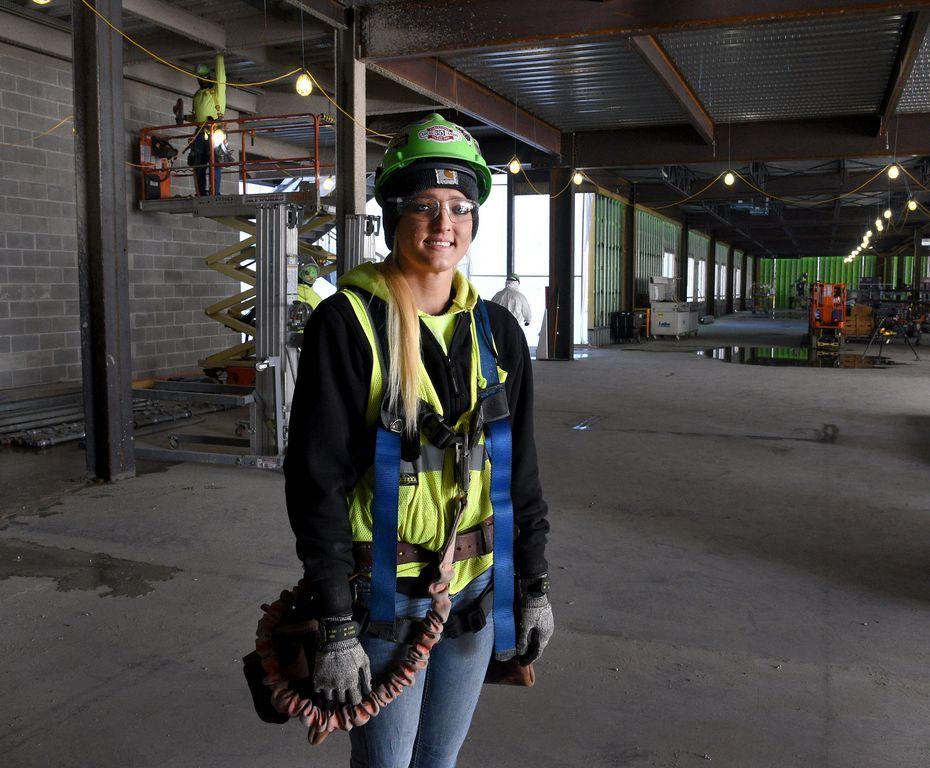By Caitlin Taylor
Monroe News, Mich.
WWR Article Summary (tl;dr) According to the National Association of Women in Construction (NAWIC) less than 10 percent of the construction industry is made up of women and most of those employed work solely in sales.
Michigan
On practically any given job site, Natalya Groff stands out among coworkers for a variety of reasons.
There’s her long blonde ponytail.
There’s her toolbelt filled with a set of pink screwdrivers, pliers and hammer.
And at 22, there’s her exceptionally young age.
But of all of her differences from coworkers, the Ottawa Lake resident stands out most for one simple attribute: She’s one of just two women laborers working on the site of the new ProMedica Charles and Virginia Hickman Hospital in Adrian.
“This job site doesn’t have many women, but it can vary at other sites,” Groff said. “Usually you’ll work with a journeyman who’s 20 to 30 years older than you.”
While her blonde ponytail is kept hidden by a lime green hardhat and her 30-pound tool belt works just the same as her coworkers’, Groff’s gender remains unique among contemporary construction sites.
Less than 10 percent of the construction industry is made up of women, according to the National Association of Women in Construction (NAWIC), and most of those employed work in solely in sales.
Despite the overwhelming lack of diversity, Groff said she doesn’t feel out of place.
In fact, she said the workplace climate is much more accommodating than some women may think.
Groff took an interest in the construction industry early on, enrolling in a skilled trades course as a student at Whiteford Agricultural Schools and then continuing her education at Monroe County Community College.
By spring, Groff will have earned a two-year degree in construction management and intends to transfer to Oakland University, Rochester, for a degree in environmental health and safety. She’s seeking a career as a construction safety engineer.
Gender disparity in the field began in the classroom, Groff said, where she was the only woman in a program of about 15 students. She’s also one of few women in a construction apprenticeship course held in Detroit.
“It’s a known fact all construction jobs are male-dominated,” Groff said. “So it was kind of just expected.”
Thanks to the MCCC program, she’s come a long way from installing cabinets in a high school career and technical education class. Now she’s trained in stick welding, certified to use several power tools and knows how to read blueprints, among many other certifications.
“I thought it was fun, working with your hands,” she said. “Framing is my favorite. You’re pretty lucky if you get to frame.”
A ‘MAN’S’ JOB
While working toward furthering her education, Groff takes jobs on construction sites to get on-the-job experience. Right now, she’s working for a metal framing and drywall company, Ohio Ceiling and Partition (OCP), at the pending Adrian ProMedica site.
“It’s kind of labor-intensive,” she said. “You have to be able to do a ‘man’s’ job, and normally women don’t like to do these kinds of jobs. But those who do are awesome.”
When Groff arrives at work, she said she gets her tools and other materials set up and then heads to what she calls her second-floor “office” — an aerial lift.
Collaborating with a “ground guy” — usually a male counterpart who’s up to 30 years her senior — she installs top track, putting vertical studs in the ceiling.
She said it’s the heavy lifting, sometimes dangerous equipment and heights that make the job traditionally a male-dominated one. Having a smaller build, she said, can make certain jobs more challenging than they would be for a man with a larger frame.
“I did get a muscle strain before from heavy lifting,” she said. “Some guys will say, ‘Don’t make her lift that,’ but you know they’re going to make you do it anyways.”
When she’s not on the aerial life, Groff said she cuts stud using an angle grinder to prepare the track for installation. She also handles tools like hand drills, screw guns, chop saws and laser levels.
WORKPLACE CLIMATE
Despite being nearly the only woman on her job site and in the classroom, Groff said she’s had primarily good experiences with her male coworkers.
The atmosphere isn’t as intimidating as some might think and generally she’s treated just like any other employee.
“It’s usually not that bad working with all of them, but you can’t talk about girl stuff,” Groff said. “Sometimes you wish you had a girlfriend.”
There have been some experiences where former supervisors from other companies didn’t trust her strength or capability with equipment or didn’t want to help her with heavy lifting or teach her new skills.
Overall, though, she said most of the men she has worked with take her seriously as a valuable addition to the crew and are willing to lend a hand when needed.
While Groff has had a good experience in her field, she said women need to be introduced to the trades before she believes they’ll believe there are jobs for them in traditionally male-dominated career fields.
“I think there’s a hard enough time pushing people into the trades as it is, so I don’t think women will overpopulate things any time soon,” she said.














































































































































































































































































































































































